
Art at Huntsman Cancer Institute
When developing plans to build Huntsman Cancer Institute, founders Jon and Karen Huntsman saw art as an important part of their vision “to make sure the environment would be as healing as the medicine.”
Today, Huntsman Cancer Institute is home to thousands of original paintings, sculpture, and pottery. The works featured here are displayed in the Kathryn F. Kirk Center for Comprehensive Cancer Care and Women’s Cancers at Huntsman Cancer Institute.
The cultural traditions of Indigenous peoples are often manifested by a connection to the land and through song, prayer, kinship, spirituality, and art—including painting, weaving, sculpture, carving, pottery, and more. Images and symbols communicate meanings of strength, inspiration, legacy, and hope.
About the Collection
Works displayed in the Kathryn F. Kirk Center are modern and contemporary pieces created by Indigenous artists. All pieces are part of the Jon M. and Karen H. Huntsman Family Collection.
Many of these works were created for the commercial art market. Extensive efforts were made to learn about the pieces’ significance and meaning from artists or their living descendants. Tribal representatives were also consulted to understand cultural significance and to ensure the objects are displayed respectfully and appropriately.
We recognize the rich history behind the collection and welcome continued opportunities for learning. Share insights at art@hci.utah.edu.
This is a modal window.
Featured Pieces
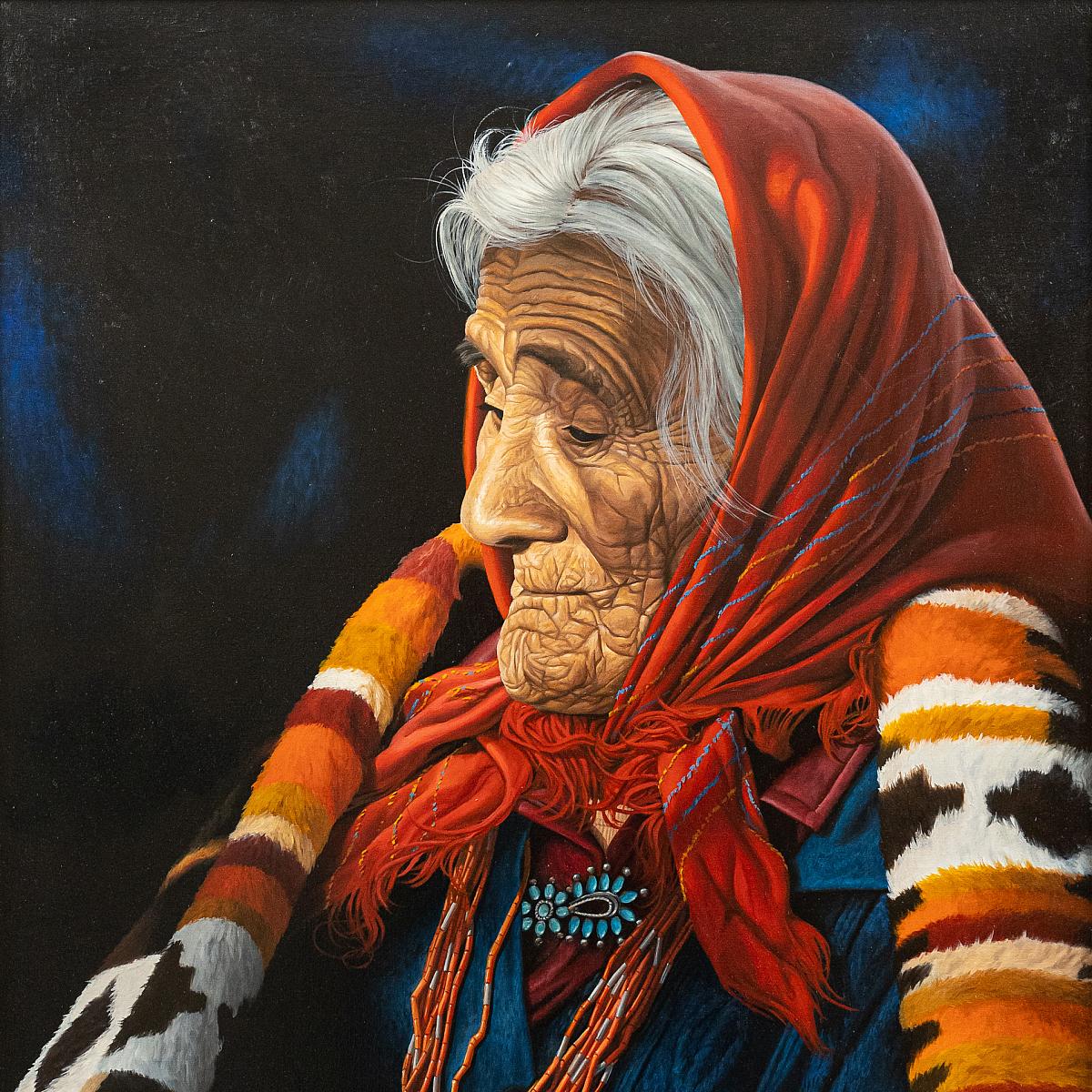
Portrait of Nellie
James Buck King depicted his grandmother in this painting (Diné, ca. 1980).
The Diné are a matriarchal society, where Naabeehó sáanii (Navajo women) are the center of the family, keepers of wisdom, and preservers of ancestral teachings.
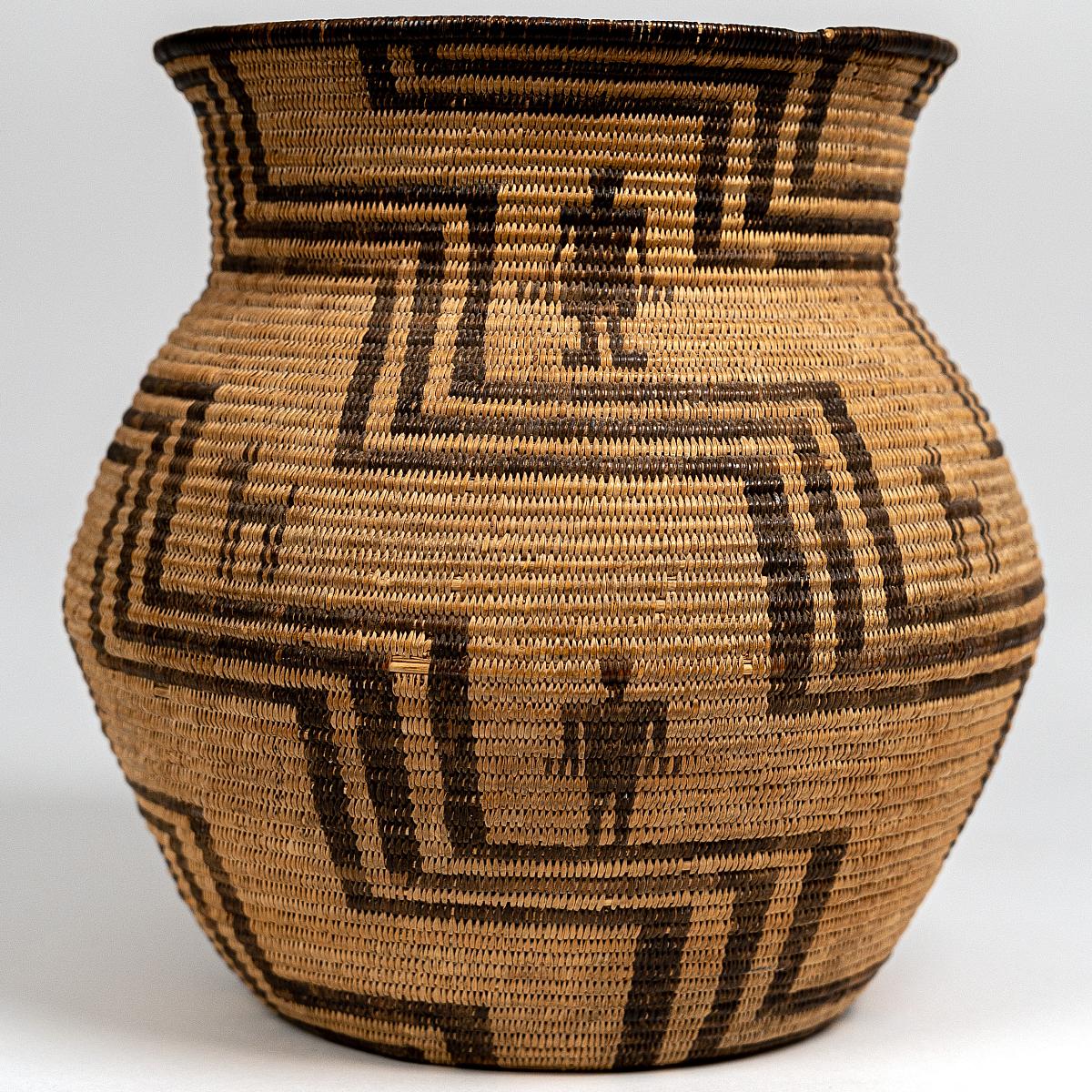
Apache Vase Basket
Apache artists are famed for their coiled basketry such as this one (ca. 1900). Weavers fashion these baskets by arranging two, three, or five rods of bundled or shredded fibers in continual spirals.
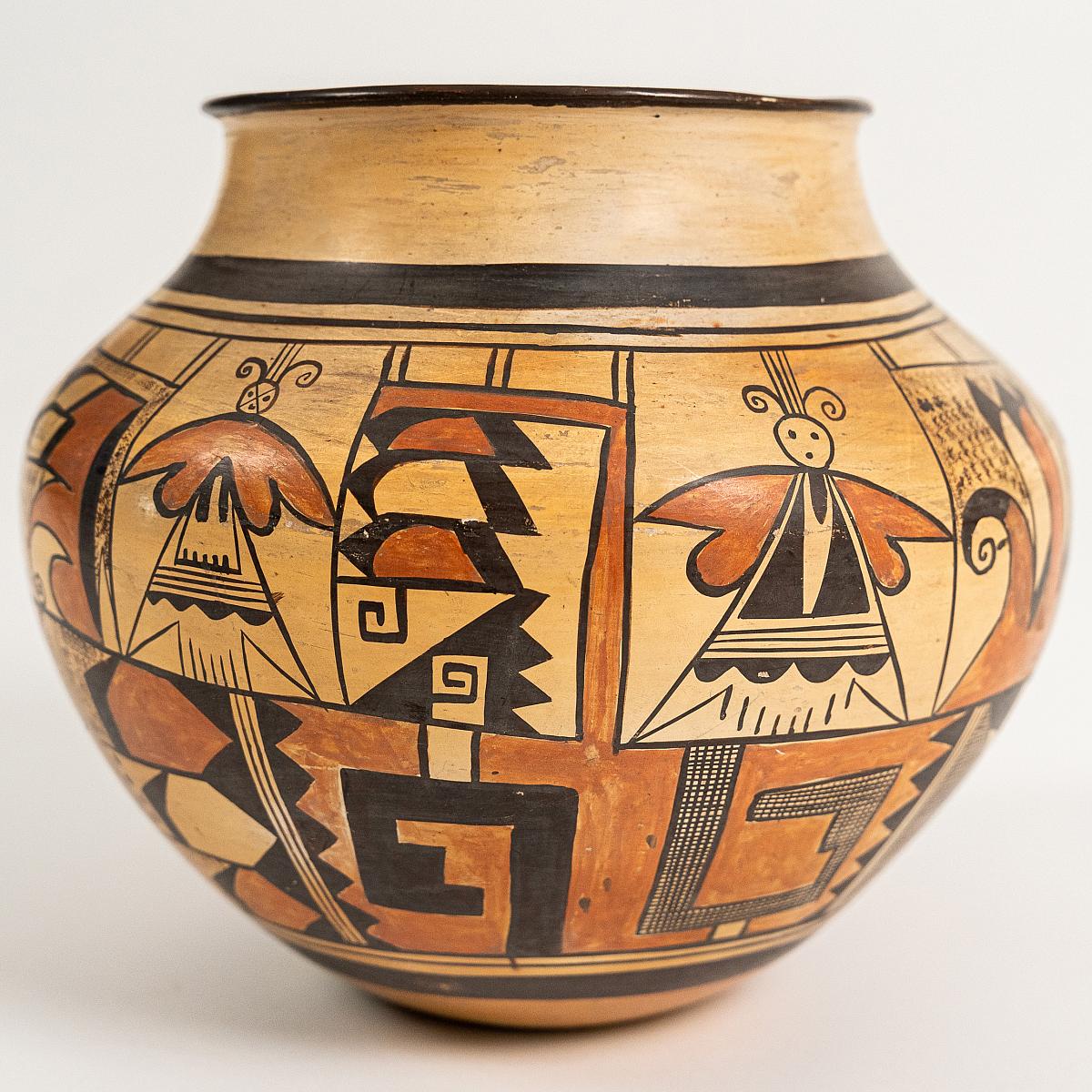
Hopi Butterfly Pot
This ceramic pot is by Daisy Hooee Nampeyo (Hopi-Tewa, ca. 1930).
In Hopi tradition, butterflies are associated with life and good health for all beings.
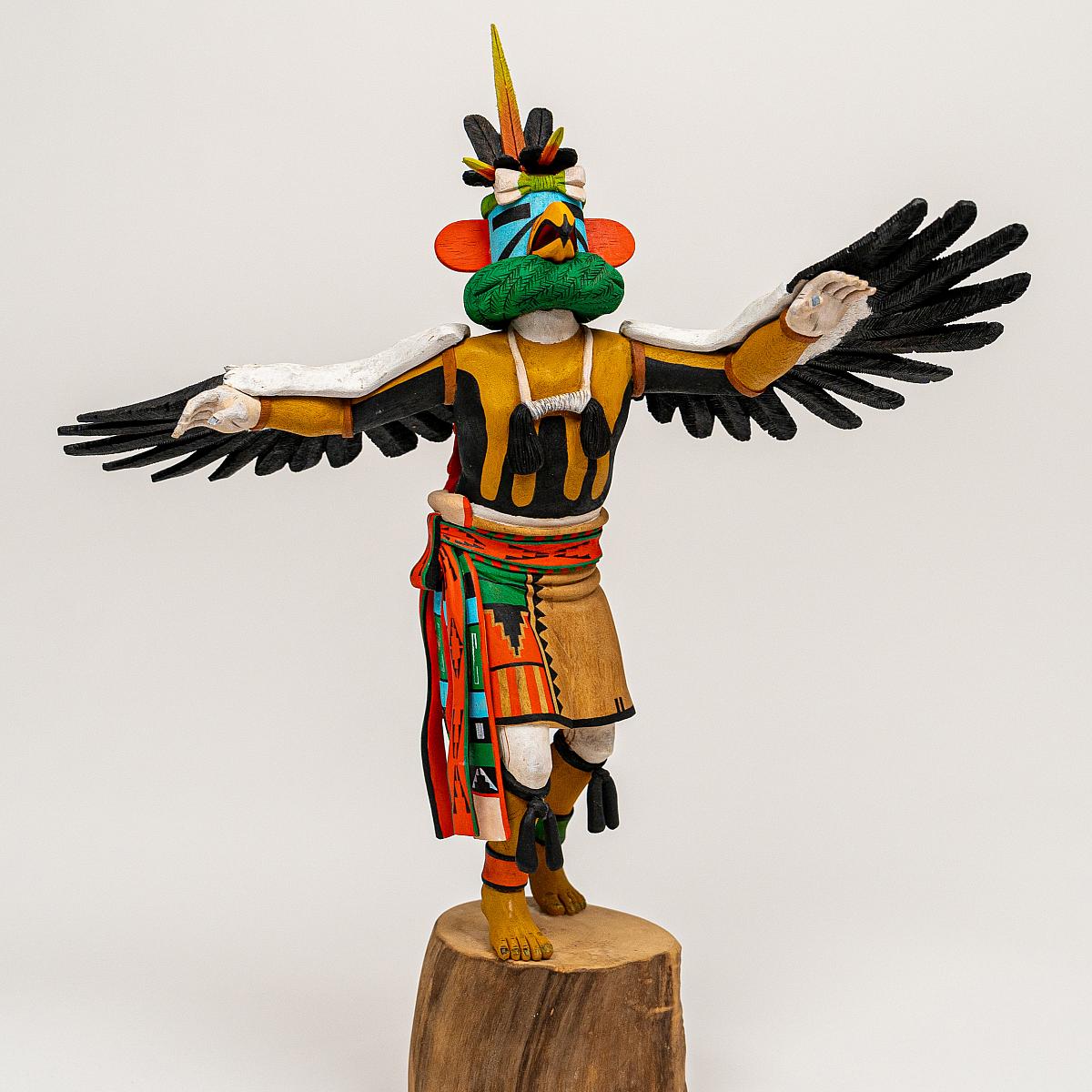
Eagle Dancer Katsina
Katsina dolls are intricately carved from a single piece of cottonwood, then colorfully decorated with paint.
This Eagle Dancer Katsina was created by Raymond Sahme (Hopi, ca. 1970).
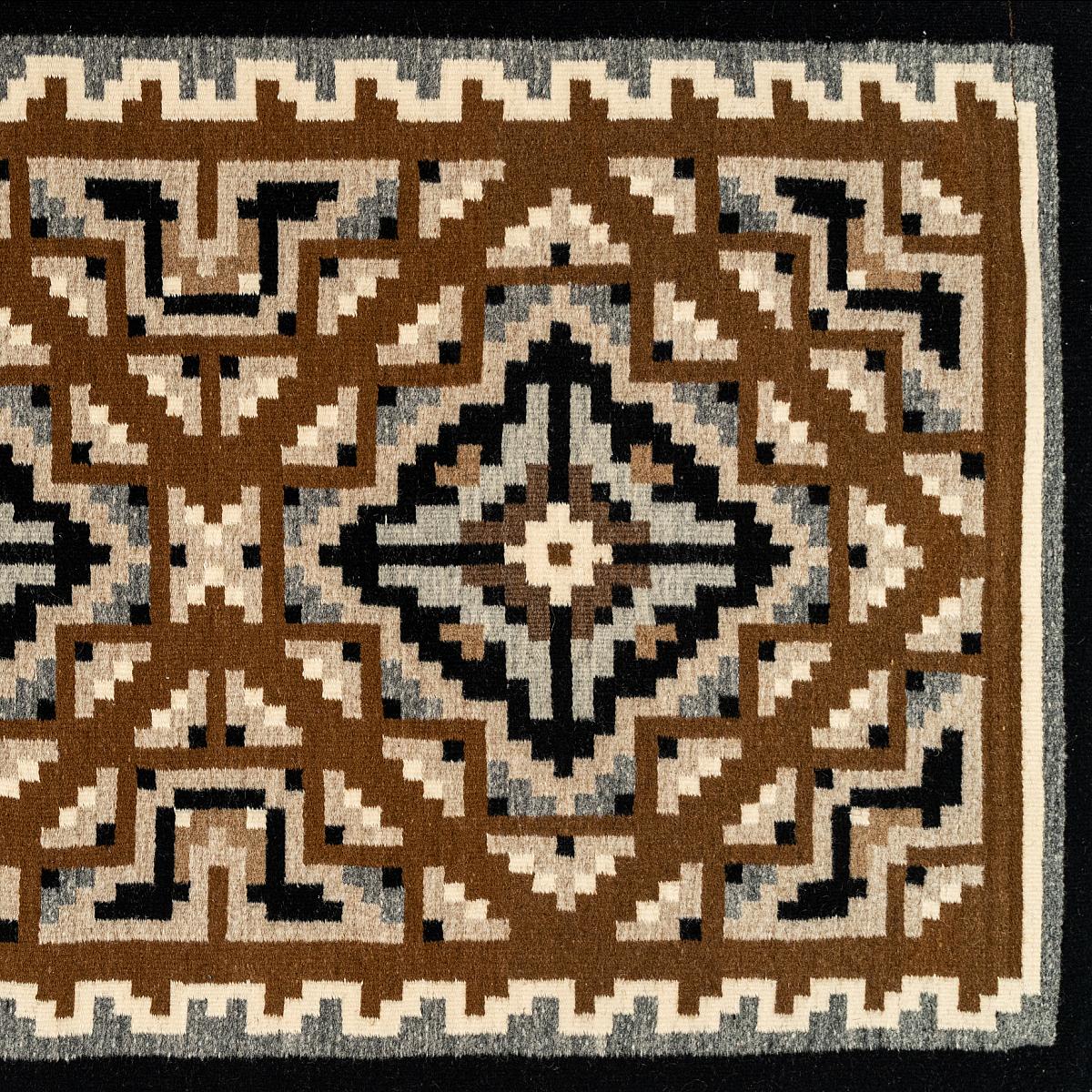
Two Grey Hills Tapestry
Many Navajo rugs have a “Spirit Line.” It is believed to allow the weaver’s thoughts, energy, and spirit to be released so they have the creativity to continue weaving.
Find this Spirit Line in the top right of the weaving. Created by Barbara Jean Teller Ornelas (Diné, ca. 1980).
“To me, weaving is healing. It is something that helps people by calming their gaze and helping them heal. I want viewers…to look at the weaving through the eyes of love. The spirit contained within the weaving will give the viewer peace.”
Special Thanks
Artists and Educators
- Dr. Joe Kee, Professor of Navajo Language and Culture, University of New Mexico
- Cecil Miles, Navajo, Carver
- Barbara Jean Teller Ornelas, Navajo, Master Weaver
- Shirley Brown, Navajo, Regional Weaver
- Ashley Tsosie, Navajo, Regional Weaver
- Phyllis Pettit Nassi, Otoe-Missouria and Cherokee, Associate Director, American Indian Program at Huntsman Cancer Institute
- Nathan Begaye, Navajo, Patient Navigator, American Indian Program at Huntsman Cancer Institute
Art Fellows
- Ali Snow, Art Collections Manager
- Kiki Karahalios
- Jace Meier
Tanner’s Indian Arts
- Joe E. Tanner, Sr., Curator
- Cindy Tanner, Curator
- Emerald Tanner, Curator
- Brad Chavez, Exhibit Specialist
- Karen Harris, Exhibit Specialist
- Randy Hosteen, Exhibit Specialist
- Kara Kubasiak, Affiliate
Display Consultants
- Peter Brill, Assistant Director for Exhibitions and Programs
- Lisa Hein, Exhibit Specialist
- John Richardson, Exhibit Specialist
- Sean Ryan, Exhibit Specialist
Natural History Museum of Utah
- Karen DuBroff, Associate Registrar for Loans and Exhibitions
- Annie T. Lawlor, Assistant Collections Manager
- Bill Thomas, Preparator
Huntsman Cancer Institute Executive Leadership
- Mary Beckerle, Chief Executive Officer
- Don Milligan, Executive Director, Cancer Hospital
- Ashlee Harrison, Executive Director, Innovation and Transformation
- Alyson Harding, Director, Support Services, Cancer Hospital
Huntsman Cancer Institute Office of Communications & Public Affairs
Huntsman Cancer Institute Environmental Services
Huntsman Cancer Foundation
- Pam Bailey, Huntsman Family Registrar
- Linda Patino, Huntsman Family Registrar
Architectural Nexus
- Lisa Ramidan, Senior Principal Architect
- Ryan Bowker, Architect
Nichols Photo Lab
Bibliography
- Acosta, Pamela, Antoinette Grajeda, Niketa Reed, and Jazlyn Sanderson. “Museum Monday: The Navajo Dress at the Museum of Native American History.” Arkansas Soul | Black and minority news in Arkansas, April 10, 2021. https://argotsoul.com/2021/04/museum-monday-navajo-dress-museum-of-native-american-history/.
- “Antelope Canyon History.” Navajo Tours, July 10, 2020. https://navajotours.com/tourist-resources/antelope-canyon-history/.
- Awawtam. "Pima Stories of the Beginning of the World" The Norton Anthology of American Literature. 7th ed. Vol. A. New York: W. W. Norton &, 2007. 22–31.
- “Basket.” Minneapolis Institute of Art. https://collections.artsmia.org/art/16555/basket-probably-akimel-oodham.
- “Basket with “Man in the Maze” Design.” Michael C. Carlos Museum, Emory University. https://collections.carlos.emory.edu/objects/34425/basket-with-man-in-the-maze-design.
- Barbara Jean Teller Ornelas. Interviewed by Ali Snow, Huntsman Cancer Institute. 20 September 2022.
- Bataille, Gretchen M., and Laurie Lisa. Native American Women: A Biographical Dictionary. New York: Routledge, 2016, 2001.
- Begay-Foss, Joyce. “They Wove for Horses: Diné Saddle Blankets.” New Mexico Department of Cultural Affairs. Accessed May 16, 2023. https://media.newmexicoculture.org/release/206/they-wove-for-horses.
- Bernbaum, Edwin. “North America: The High and the Beautiful.” Chapter. In Sacred Mountains of the World, 2nd ed., 196–231. Cambridge: Cambridge University Press, 2022. doi:10.1017/9781108873307.011.
- Berlo, Janet Catherine, and Allen Wardwell. Native Paths American Indian Art from the Collection of Charles and Valerie Diker. New York: Metropolitan Museum of Art, 1998.
- “Black and White Jar.” Art Institute of Chicago. https://www.artic.edu/artworks/225610/black-and-white-jar.
- Brugge, David M., Raymond Wilson. Administrative History: Canyon de Chelly National Monument Arizona. United States Department of the Interior, National Park Service, January 1976. https://www.nps.gov/parkhistory/online_books/cach/adhi.htm.
- Bryan, Nonabah G., Stella Young, Charles Keetsie Shirley. Navajo Native Dyes: Their Preparation and Use. United States Department of the Interior, Office of Indian Affairs, 1940. Retrieved from the University of Arizona. https://www2.cs.arizona.edu/patterns/weaving/monographs/bys_dyes.pdf.
- Campbell, Gordon. The Grove Encyclopedia of Decorative Arts. New York, NY: Oxford University Press, 2006.
- Cantrell, Steve, and Maxine McBrinn. “Turquoise, Water, Sky: The Stone and Its Meaning.” Museum of Indian Arts & Culture. https://www.indianartsandculture.org/whatsnew/&releaseID=292.
- “Canyon de Chelly, National Monument Arizona.” National Parks Service: U.S. Department of the Interior. https://www.nps.gov/cach/learn/historyculture/index.htm.
- The Changing Presentation of the American Indian: Museums and Native Cultures. Washington, D.C.: National Museum of the American Indian, 2004.
- “Changing Woman: Myth, Metaphor, and Pragmatics.” University of Virginia. https://xroads.virginia.edu/~MA97/dinetah/change2.html.
- “Chief’s Blanket: Diné/Navajo.” The Metropolitan Museum of Art. https://www.metmuseum.org/art/collection/search/823661.
- “Contemporary Weavings.” Indiana University Museum of Archaeology and Anthropology Digital Exhibits. https://dlib.indiana.edu/omeka/mathers/exhibits/show/navajo_weavings/contemporary_weavings
- “Daisy Hooee Nampeyo.” Smithsonian American Art Museum. https://americanart.si.edu/artist/daisy-hooee-nampeyo-6187.
- “Diné (Navajo) Native North American: Man’s Wearing Blanket (Chief Blanket, Phase III), ca. 1865 - ca. 1880.” Rhode Island School of Design Museum. https://risdmuseum.org/art-design/collection/mans-wearing-blanket-chief-blanket-phase-iii-42088.
- Dittemore, Diane. “The Nampeyo Legacy: A Family of Hopi-Tewa Potters.” Southwest Art Magazine, August 25, 2010. https://www.southwestart.com/articles-interviews/feature-articles/the_nampeyo_legacy.
- Duane H. King. Exhibiting Culture: American Indians and Museums. 45 Tulsa L. Rev. 25, 2013.
- “Elbridge Ayer Burbank.” Smithsonian American Art Museum. https://americanart.si.edu/artist/elbridge-ayer-burbank-656.
- “Eye Dazzler.” Saint Louis Art Museum. https://www.slam.org/collection/objects/14195/.
- ““Eye Dazzler” Weaving.” Art Institute Chicago. https://www.artic.edu/artworks/22379/eye-dazzler-weaving.
- Feinman, Gary, and James Skibo. Pottery and People. University of Utah Press, 2011. muse.jhu.edu/book/41422.
- Fewkes, Jesse Walter. “THE BUTTERFLY IN HOPI MYTH AND RITUAL.” American Anthropologist 12. 1910: 576-594.
- Frederick Dockstader Collection1901-1998. http://azarchivesonline.org/xtf/view?docId=ead%2Fnau%2Fdockstader_frederick.xml.
- ““Germantown Eye Dazzler” Rug.” Art Institute Chicago. https://www.artic.edu/artworks/155968/germantown-eyedazzler-rug.
- Hall, Stephanie. “Caught My Eye: The Girl in the Elk Tooth Dress: Folklife Today.” The Library of Congress, November 21, 2018. https://blogs.loc.gov/folklife/2018/11/girl-in-the-elk-tooth-dress/.
- “Hopi Butterfly Dance - Circle of Dance - October 6, 2012 through October 8, 2017 - The National Museum of the American Indian in New York.” Smithsonian NMAI. https://americanindian.si.edu/exhibitions/circleofdance/hopi.html.
- “Hunts Mesa.” Geographic Names Information System: United States Geological Survey, United States Department of the Interior. https://edits.nationalmap.gov/apps/gaz-domestic/public/summary/6145
- Jakobsen, Mads. “The Full History of Navajo Blankets and Rugs.” Heddels, May 9, 2018. https://www.heddels.com/2017/04/navajo-blankets-and-rugs/.
- Joe Kee. Interviewed by Ali Snow, Huntsman Cancer Institute. April 2022.
- Joe Kee. Interviewed by Kiki Karahalios, Huntsman Cancer Institute. 30 January 2023.
- “Kivas.” The Museum Collections of Chaco Culture, National Park Service Museum. https://www.nps.gov/museum/exhibits/chcu/slideshow/kivas/kivasintro.html.
- Liebenson, Bess. “Reading into the Navajos’ Rugs.” The New York Times, December 3, 2000. https://www.nytimes.com/2000/12/03/nyregion/reading-into-the-navajos-rugs.html.
- Linford, Laurance D. Tony Hillerman's Navajoland: Hideouts, Haunts, and Havens in the Joe Leaphorn and Jim Chee Mysteries. United States: University of Utah Press, 2005.
- Lomahaftewa, Gloria. “Circle of Dance: Hopi Butterfly Dance.” Smithsonian National Museum of the American Indian. https://americanindian.si.edu/exhibitions/circleofdance/hopi.html.
- “The Long Walk: The Navajo Treaties.” Smithsonian National Museum of the American Indian. https://americanindian.si.edu/nk360/navajo/long-walk/long-walk.cshtml.
- Makes, Raven. “Traditional Textiles and the Navajo Tree of Life.” Raven Makes Gallery, July 6, 2018. https://www.ravenmakesgallery.com/blogs/news/traditional-textiles-and-the-navajo-tree-of-life.
- “Margaret Tafoya.” National Endowment for the Arts. https://www.arts.gov/honors/heritage/margaret-tafoya.
- “Margaret Tafoya.” National Museum of Women in the Arts. https://nmwa.org/art/artists/margaret-tafoya/.
- M'Closkey, Kathy. Swept Under the Rug: A Hidden History of Navajo Weaving. United States: University of New Mexico Press, 2002.
- Moore, J. B., Alexander E. Anthony, J. Brent Ricks, and Marian E. Rodee. The Catalogues of Fine Navajo Blankets, Rugs, Ceremonial Baskets, Silverware, Jewelry & Curios: Originally Published between 1903 and 1911. Albuquerque, NM: Avanyu Publishing, Inc., 1987.
- “Moqui-Style Sarape.” Art Institute of Chicago. https://www.artic.edu/artworks/148331/moqui-style-sarape
- “Native American Animals: The Turtle (Kéya) Symbolizes Grandmother Earth (Uŋčí makȟá).” Native Hope. https://blog.nativehope.org/native-american-animals-turtle-k%C3%A9ya.
- Naming, Les. “Infinity of Nations: Art and History in the Collections of the National Museum of the American Indian.” Smithsonian National Museum of the American Indian. https://americanindian.si.edu/exhibitions/infinityofnations/southwest/264462.html
- “Nampeyo Showcase.” Arizona State Museum. https://statemuseum.arizona.edu/online-exhibit/nampeyo-showcase.
- “Navajo Ceremonial Basket Interpretations.” Natural History Museum of Utah. https://nhmu.utah.edu/sites/default/files/attachments/The%20Navajo%20Ceremonial%20Basket%20Interpretations.pdf.
- “Navajo Saddle Blankets from the Edwin L. And Ruth E. Kennedy Southwest Native American Collection.” Ohio University. https://www.ohio.edu/sites/default/files/sites/museum/NavajoSaddleBlanketTeacherPacket.pdf.
- Neyland, Charlotte S. Southwest Traveler - A Travelers Guide to Southwest Indian Arts and Crafts. United States: American Traveler Press, 1992.
- “Obituary: James Buck King, Sr. ‘He Loved Painting’ - ICT News.” https://ictnews.org/obituaries/obituary-james-buck-king-sr-he-loved-painting.
- “Pattern & Disruption: Diné Lifeways and Embedded Mathematics.” Kennedy Museum of Art, Ohio University. 2020. https://www.ohio.edu/sites/default/files/2020-08PatternDisruptionDiscussionART1210.pdf
- “Plains and Plateau Beadwork.” Museum of Natural and Cultural History, University of Oregon. https://mnch.uoregon.edu/collections-galleries/plains-and-plateau-beadwork.
- “Polychrome Jar with Rainbow, Macaw, and Floral Motifs.” The Art Institute of Chicago. https://www.artic.edu/artworks/189293/polychrome-jar-with-rainbow-macaw-and-floral-motifs.
- “Rainmakers From the Gods.” Peabody Museum of Archaeology & Ethnology, Harvard University. https://peabody.harvard.edu/OE-rainmakers-gods.
- “Seed Jar with Sikyatki Motifs.” The Art Institute of Chicago. https://www.artic.edu/artworks/180751/seed-jar-with-sikyatki-motifs.
- “Spider Woman.” Hillerman University of New Mexico Libraries. https://ehillerman.unm.edu/node/2028
- “Spider Woman.” A Navajo Legend. http://www.native-languages.org/navajostory.htm.
- “Spider Woman Cross.” Denver Art Museum. https://www.denverartmuseum.org/en/object/2018.685
- “Storage Jar.” Art Institute Chicago. https://www.artic.edu/artworks/190994/storage-jar.
- “Storm Pattern Circular Rug.” Kennedy Museum of Art, Ohio University. https://www.ohio.edu/museum/art/virtual-exhibitions-tours/pattern-and-disruption-virtual/pattern-weavings/fourworlds-9.
- “The Story of Monument Valley Navajo Tribal Park.” Visit Utah. https://www.visitutah.com/articles/story-of-monument-valley.
- “Teen Nos Pos Rug.” Kennedy Museum of Art, Ohio University. https://www.ohio.edu/museum/art/virtual-exhibitions-tours/pattern-and-disruption-virtual/pattern-weavings/gallery2-0-2
- “Wearing Blanket.” Art Institute Chicago. https://www.artic.edu/artworks/210026/wearing-blanket
- “Wearing Blanket.” The Metropolitan Museum of Art. https://www.metmuseum.org/art/collection/search/313232?sortBy=Relevance&ao=on&ft=Navajo&offset=0&rpp=40&pos=7
- “Wearing Blanket.” The Metropolitan Museum of Art. https://www.metmuseum.org/art/collection/search/313232.
- “Weaving Tools.” Arizona State Museum. The University of Arizona. https://statemuseum.arizona.edu/online-exhibit/19-century-navajo-weaving-asm/weaving-tools.
- Webster, Laurie D., Louise I. Stiver, D. Y. Begay, Lynda Teller Pete, and Ann Lane Hedlund. Navajo Textiles: The Crane Collection at the Denver Museum of Nature and Science. University Press of Colorado, 2017. https://www.jstor.org/stable/j.ctt1r6b076.
- “Wedding Vase.” National Museum of the American Indian. https://americanindian.si.edu/collections-search/objects/NMAI_280492.
- “Women Have Long Been the Leaders in Navajo Culture. Now They’re Steering the Fight against Covid.” The Guardian, November 20, 2020. https://www.theguardian.com/us-news/2020/nov/20/navajo-nation-women-leaders-coronavirus-matriarchy-new-mexico.